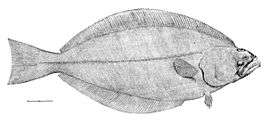Greenland halibut
| Greenland Halibut | |
|---|---|
 | |
| Scientific classification | |
| Kingdom: | Animalia |
| Phylum: | Chordata |
| Class: | Actinopterygii |
| Order: | Pleuronectiformes |
| Family: | Pleuronectidae |
| Subfamily: | Pleuronectinae |
| Genus: | Reinhardtius T. N. Gill, 1861 |
| Species: | R. hippoglossoides |
| Binomial name | |
| Reinhardtius hippoglossoides (Walbaum, 1792) | |
The Greenland halibut or Greenland turbot (Reinhardtius hippoglossoides) belongs to the Pleuronectidae family (the right eye flounders), and is the only species of the genus Reinhardtius. It is a deep water fish, ranging between about 200 and 1,600 m (700 and 5,200 ft), and is found in the northern Atlantic and northern Pacific Oceans.
The Greenland halibut is a flatfish, and the left eye has migrated during the fish's development so that it is on the right side of the head. However, in this fish, it has not moved as far as in bottom-dwelling flatfish and the fish can probably see forwards. The Greenland halibut can swim in a vertical position and both sides of its body are a speckled brown colour, but the left side is rather paler than the right. This fish is used for human consumption and is caught mostly by trawling. Greenpeace considers the fishery unsustainable and has added the Greenland halibut to its seafood red list.
Description
Its morphology with the left eye positioned on the dorsal ridge of the forehead gives it an appearance of a cyclops when looking straight at it. The central position of the left eye in the Greenland halibut probably gives it a much wider range of peripheral vision in comparison to other flatfish where the eye has migrated completely. The body shape is elongated and compressed dorsal-ventrally and muscles on both sides are equally developed. Both sides are pigmented; however the left blind side is slightly lighter in color than the right side.
Its physical appearance suggests it to be a vigorous swimmer that can swim in a vertical position. Vertical swimming has been observed during tagging experiments. However, video analyzing of Greenland halibut behavior in front of a bottom trawl showed no sign of swimming in a vertical position. Even though most Greenland halibut are caught in bottom fishing gears (trawl, longline and gillnet) they have also been caught in surface drift nets which indicates that they can have a pelagic occurrence. Stomach analysis has also shown that the diet consists mostly of pelagic or bathypelagic organisms. Even though the Greenland halibut is a flatfish it does at times behave more like a roundfish.
Distribution
It is a deepwater fish distributed mostly from 200 to 1600 m, but has been caught in deeper depths of 2,200 m (7,200 ft). It is mainly found in waters with temperatures from 1-4 °C, but has also observed at sub-zero temperatures down to -2.1 °C. It has a circumpolar distribution in the Northern Hemisphere and is found in both the North Atlantic and the North Pacific oceans.
Sustainable consumption
In 2010, Greenpeace International has added the Greenland halibut to its seafood red list. "The Greenpeace International seafood red list is a list of fish that are commonly sold in supermarkets around the world, and which have a very high risk of being sourced from unsustainable fisheries."[1]
References
External links
- Froese, Rainer and Pauly, Daniel, eds. (2008). "Reinhardtius hippoglossoides" in FishBase. February 2008 version.